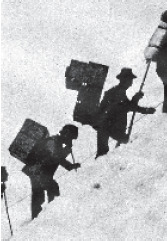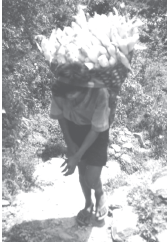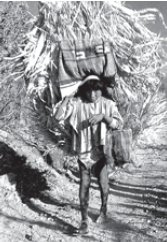|
“An unbroken line of men, stretching into the cold skies, provides the stampede with its most memorable spectacle on the slopes of the Chilkoot Pass.” This spectacle “at one glance mirrors all the terror, all the hardships, and all the yearning” of the Klondike gold rush of 1898. The Klondike Fever by Pierre Berton. The Canadian Mounties placed a scale at the top of Chilkoot Pass and weighed every single burden for the 22,000 men who made the crossing that year. Every man entering Canada had to have at least one ton of supplies moved into Canada before they were allowed to continue down the river into the Yukon Territory. In 1898, every single load was carried by the prospectors themselves or their hired porters, a majority of whom were the local Native American Tlingits, Chilkoot, Chilkats, and Stikines tribes. “Over the mountains they stolidly trudged... a tumpline taut around their flat foreheads, a stout stick in one hand.” This is as good a scientific and historical record as can be found for the human load carrying capacity. The following are some of the more interesting abbreviated stories. Even seasoned military men and explorers, such as Frederick Schwatka (1883:13, 23-24), who at first shuddered at hiring Chilkoot packers, who would “take no less than $9-12 per 100 lbs” and yielded no bulk discount for his large party and load of roughly 2 tons, quickly came to admire their packing prowess. “The amount some of these packers carry seems marvelous and makes estimates for pack mules or trains therefore seem superfluous. Their only packing gear is a couple of bands, one passing over the forehead, where it is flattened out into a broad strip, and the other over the arms and across the breast, the two meet behind on a level with the shoulder, and are there attached to lashings more or less intricate, according to the nature of the material to be transported.” “If a box or stiff bag, the breast band is so arranged in regard to length that when the elbow is placed against it (the box) the strip fits tightly over the extended forearm across the palm of the hand bent backwards. The head-band is then the width of the hand beyond this. At least I saw a few Indians arranging their packs and their harness according to this mode. The harness proper will not weigh over a pound, and the lashing according to its length. The strip across the head and breast is of untanned deer skin about 2 inches wide, with holes or slits in the ends protected from tearing out by spindles or bone or ivory.” Tlingits were trained from an early age to engage in the rugged physical tasks involved in packing. Parties often consisted not only of men, but also women, children, slaves (at least through the 1870s) and dogs (increasingly after the demise of slavery). Frederick Funston (1896:2-3) reported that his expedition “divided our goods into seven packs and engaged five men and two women to carry these loads to the summit of the pass... The Indians supported the loads on their backs by the aid of deerskin bands, passing across the forehead. Several children carried on their backs light loads, consisting of food and cooking utensils for the use of the Indians, while two of the dogs also wore packs.” Pack loads varied from 36 to 137 pounds in weight, with boys carrying the lighter loads and men the heavier, according to Schwatka. J. B. Moore (in Greer 1995:50) recorded that “native women and their young daughters and sons from ten years of age were also packing from fifty to seventy five and one hundred pounds on their backs for miners, earning from ten to twenty dollars per day.” Oglivie (1913:132-134), the Canadian surveyor who made the crossing with the legendary Tagish-Tlingit packer Jim Mason (Keish, “Lone Wolf”), dubbed him “Skookum (the Chinook term for strong) Jim” for his feat of carrying 156 pounds of bacon over the pass in a single trip. He noted, “This might be considered a load anywhere on any roads, but over the stony moraine of a glacier, as the first half of the distance is, and then up a steep pass, climbing more than 3000 feet in six or seven miles, some of it so steep that the hands have to be used to assist one up, certainly is a stiff test of strength and endurance.” Perhaps the highest claim for a Native packload was made by a very |
||||||||
 |
|||||||||
 |
|||||||||
 |
|||||||||
copyright 2005 - Richard D Fisher - DigitalTeamWorks.com